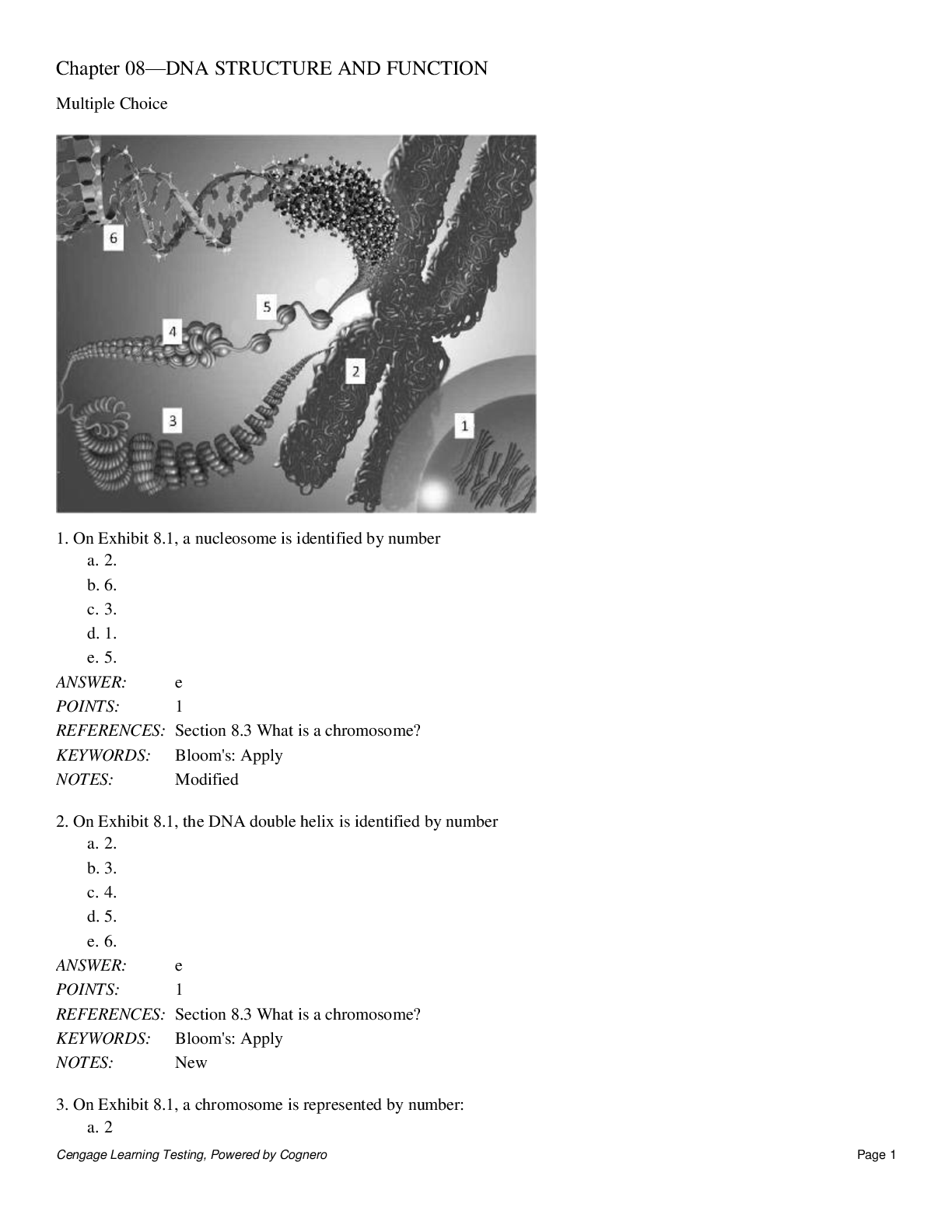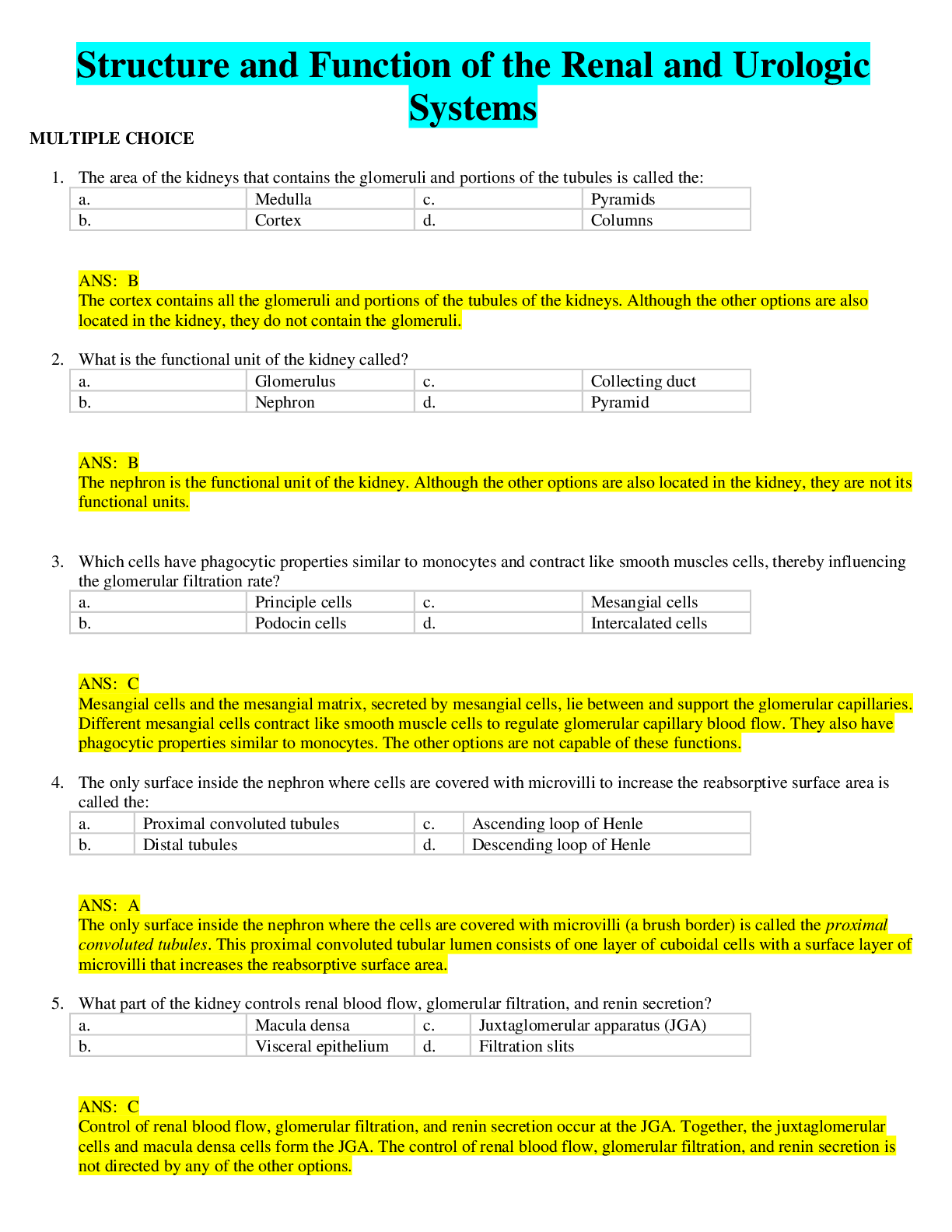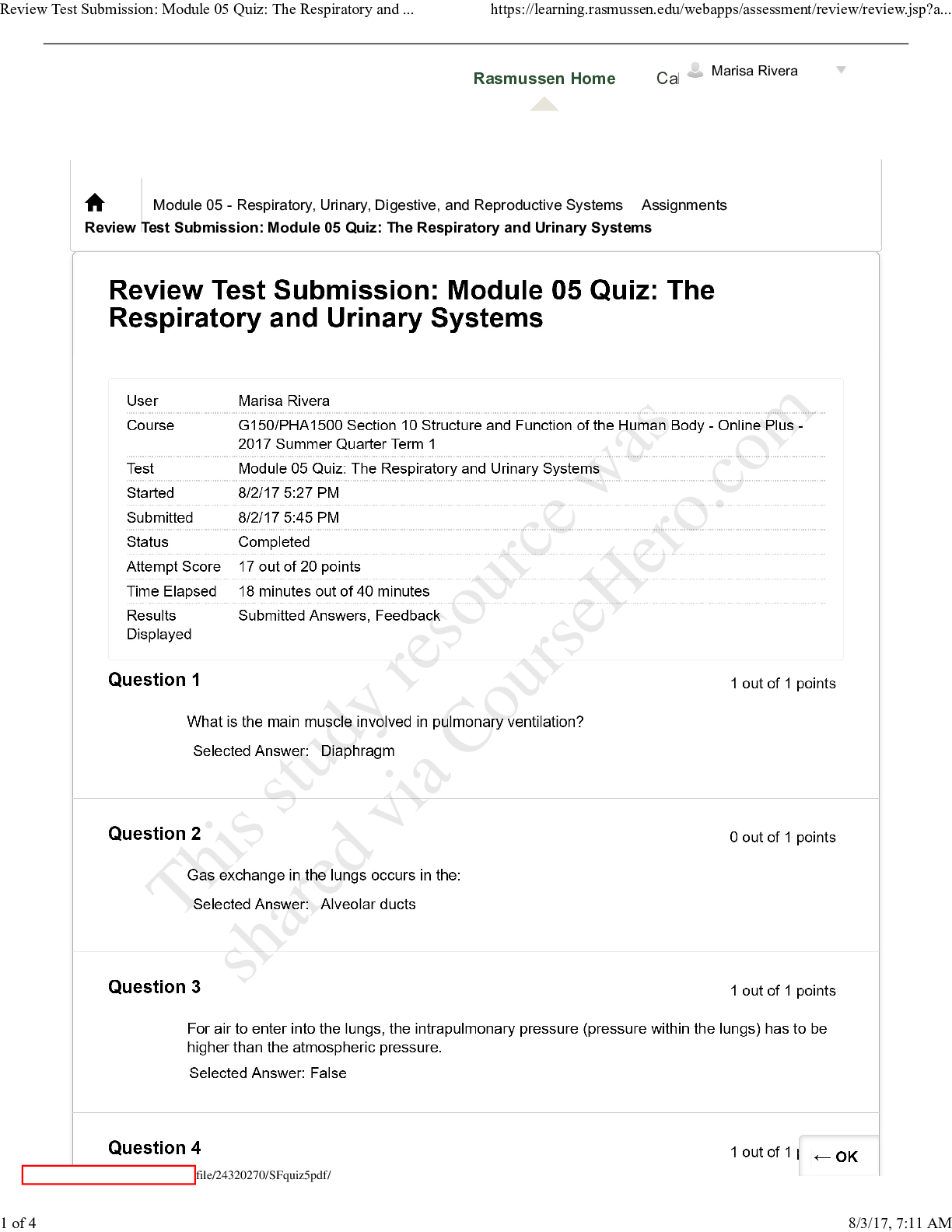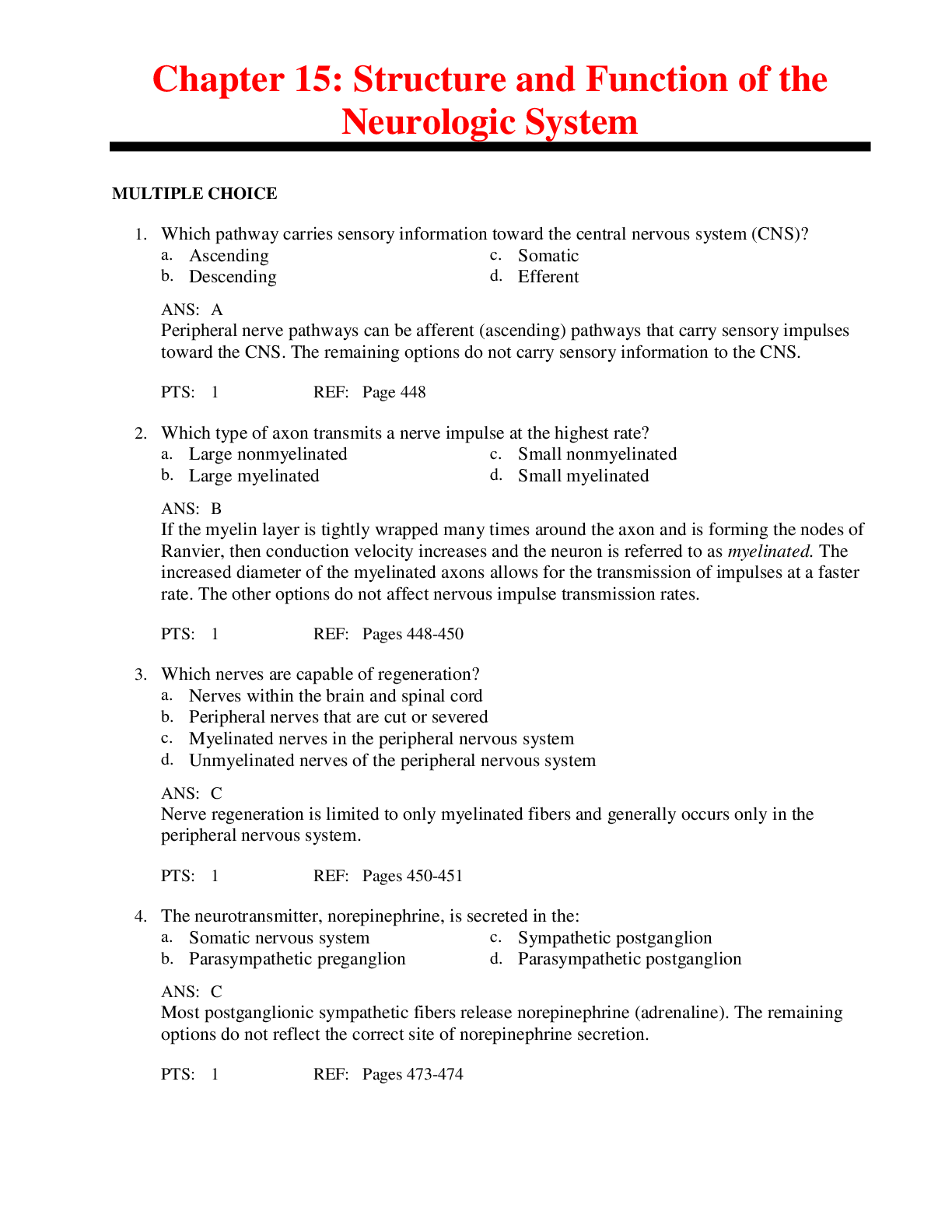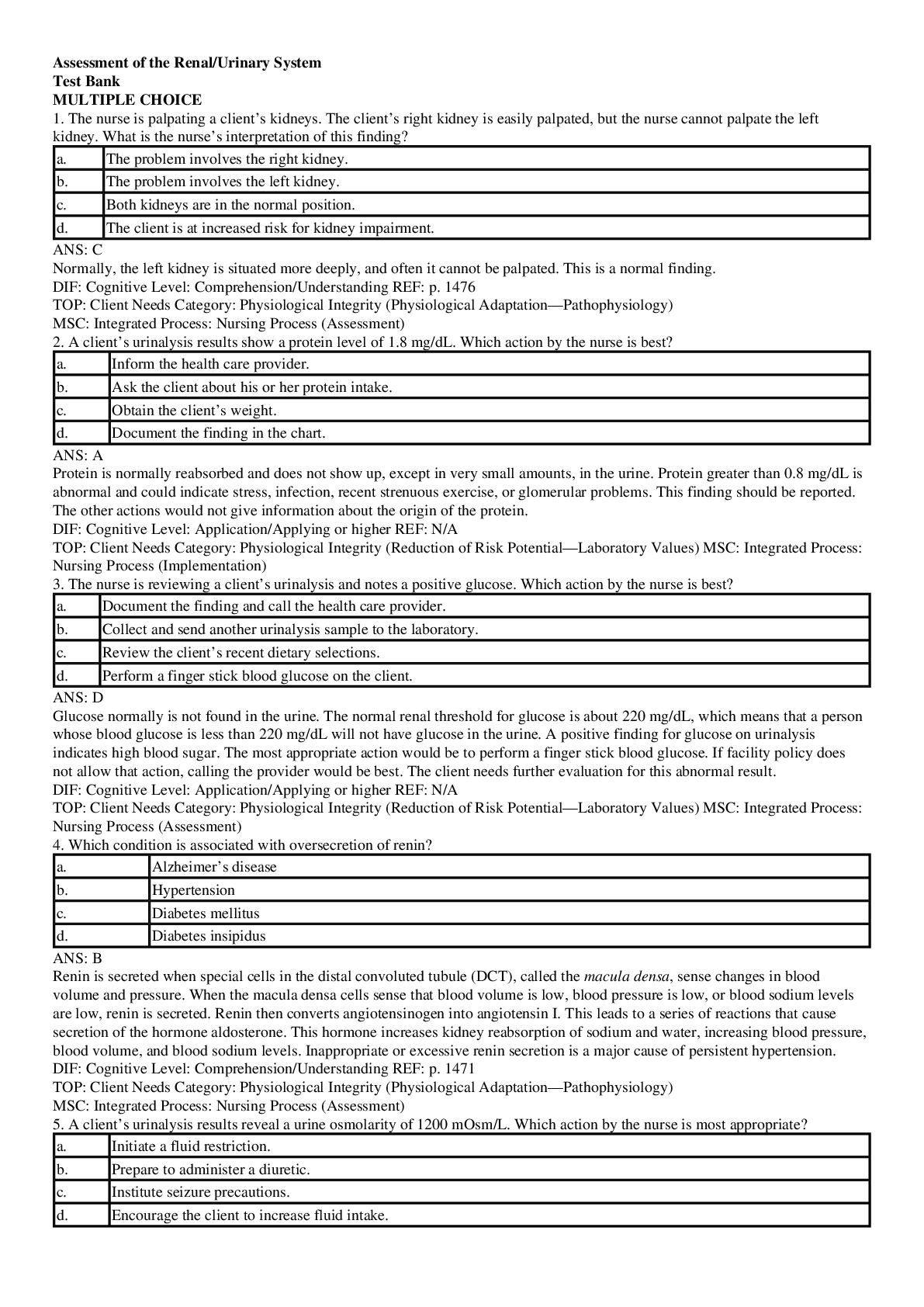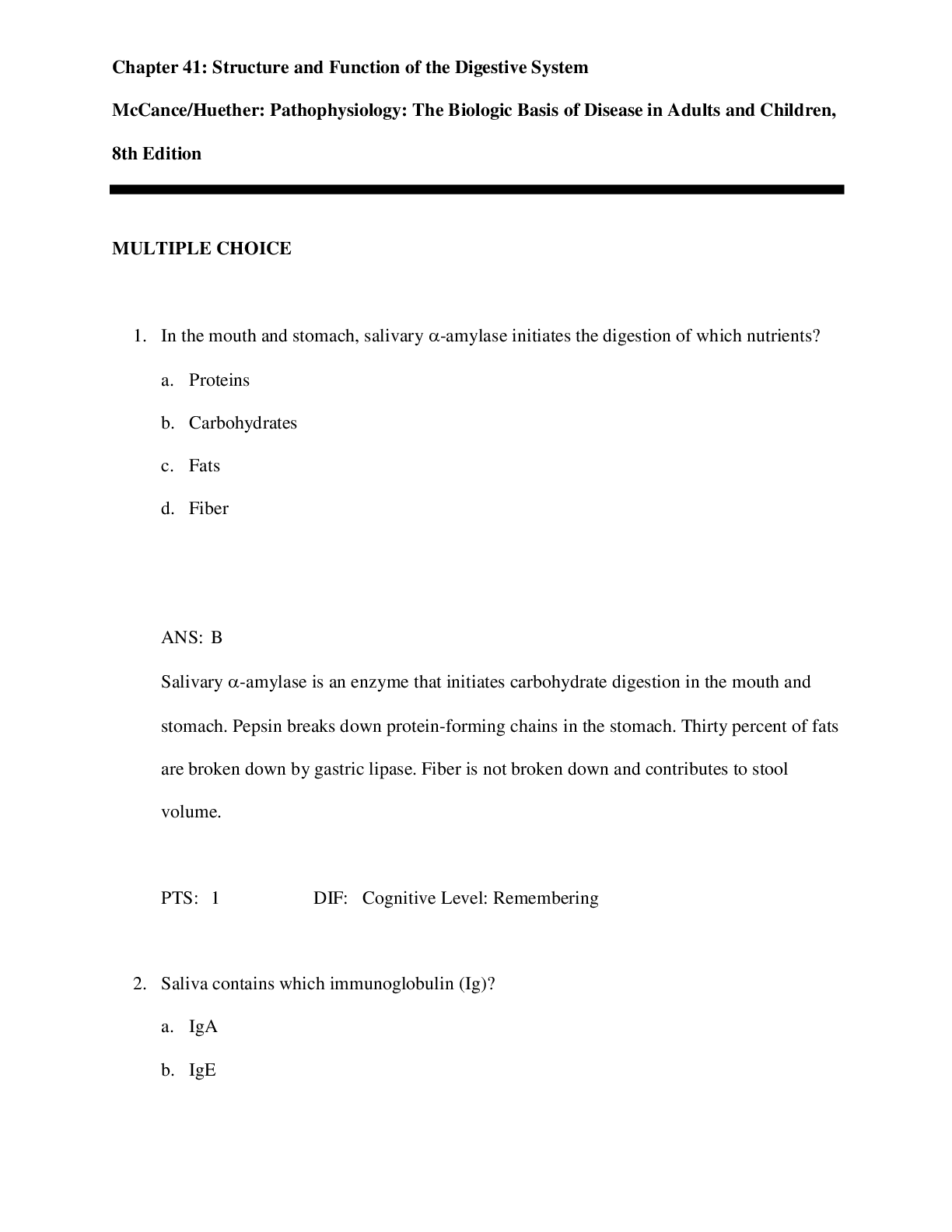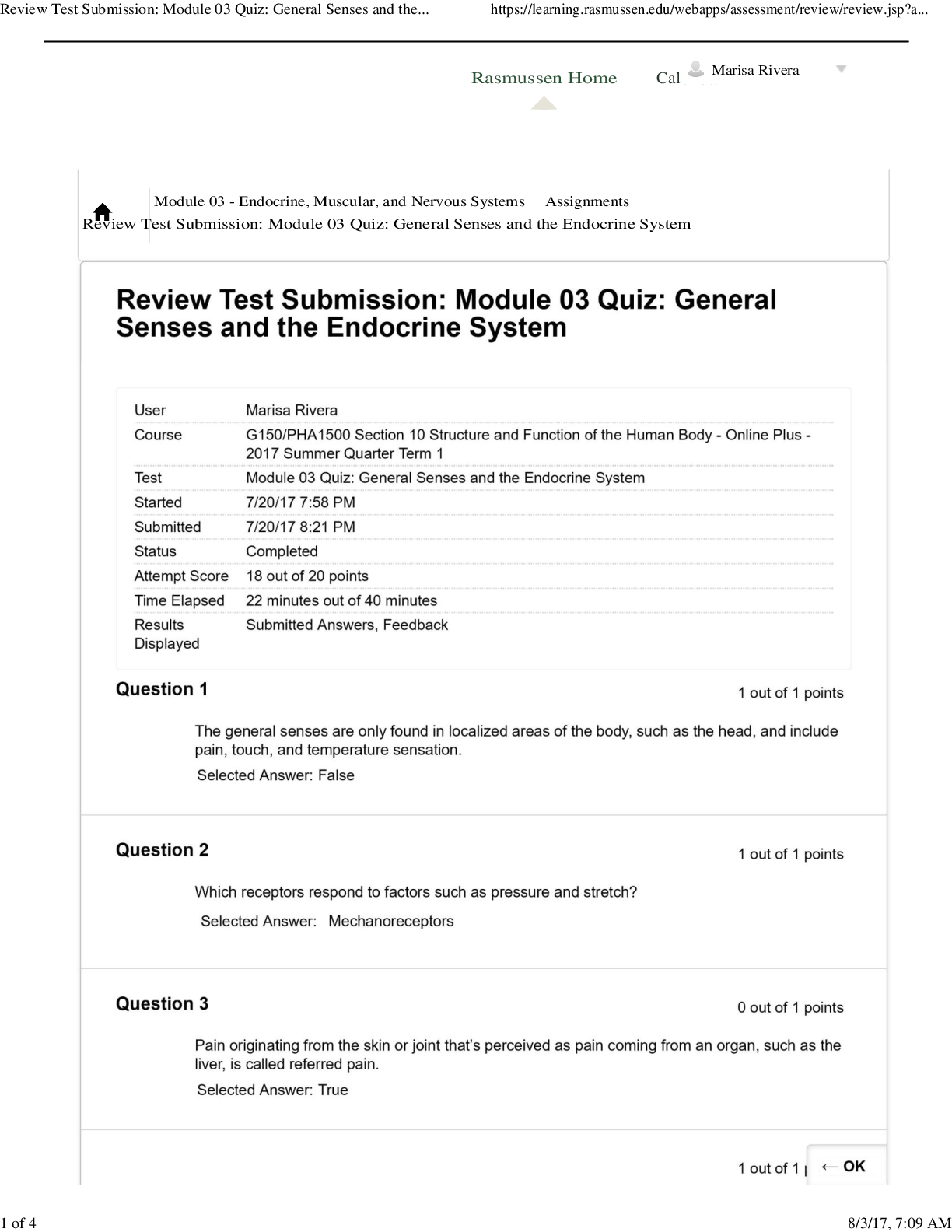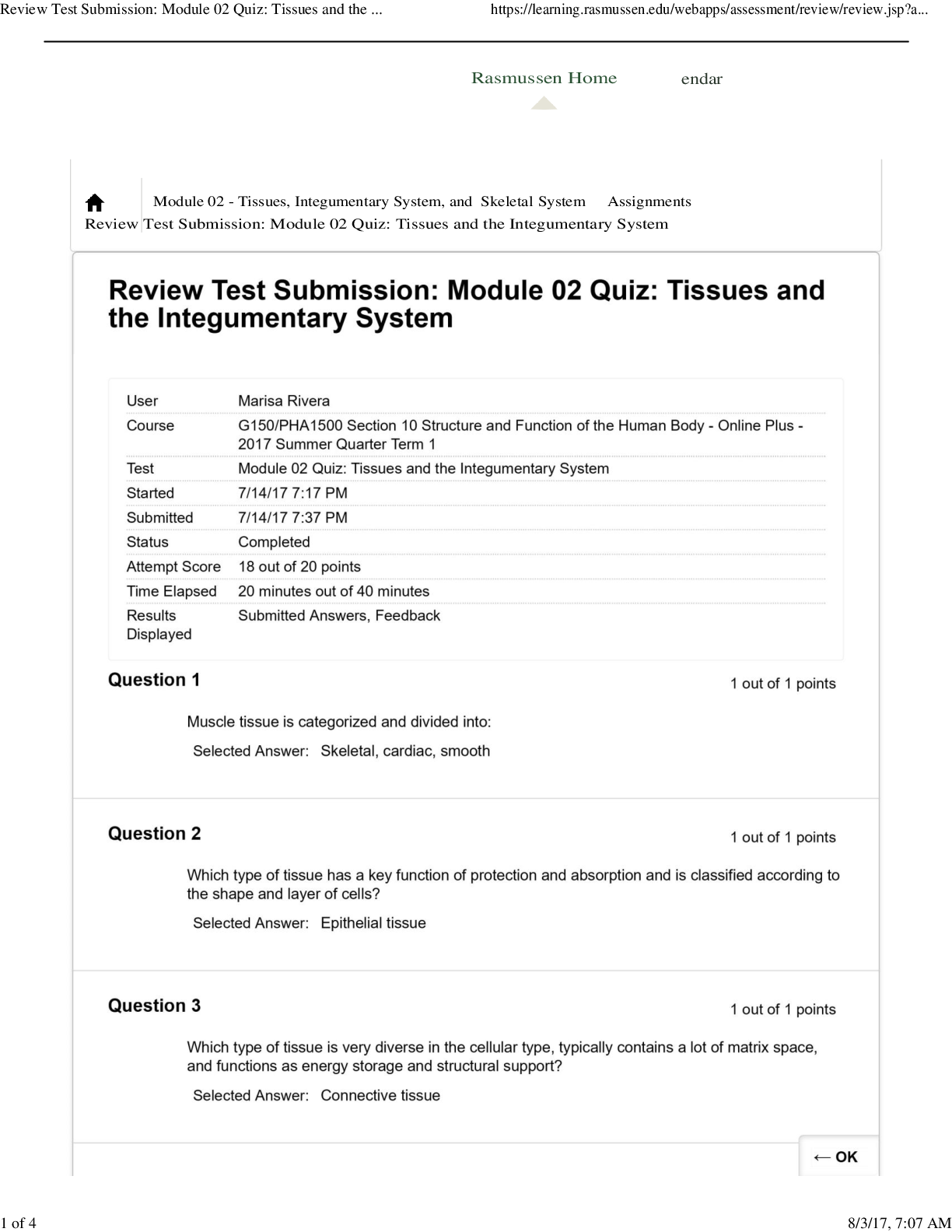*NURSING > QUESTIONS & ANSWERS > NURSING 717 / NURS 717 : Chapter 37: Structure and Function of the Renal and Urologic Systems: Hunte (All)
NURSING 717 / NURS 717 : Chapter 37: Structure and Function of the Renal and Urologic Systems: Hunter College - Cuny (ALL CORRECT ANSWERS)
Document Content and Description Below
Chapter 37: Structure and Function of the Renal and Urologic Systems MULTIPLE CHOICE 1. The area of the kidneys that contains the glomeruli and portions of the tubules is called the: a. Medu... lla c. Pyramids b. Cortex d. Columns 2. What is the functional unit of the kidney called? a. Glomerulus c. Collecting duct b. Nephron d. Pyramid 3. Which cells have phagocytic properties similar to monocytes and contract like smooth muscles cells, thereby influencing the glomerular filtration rate? a. Principle cells c. Mesangial cells b. Podocin cells d. Intercalated cells 4. The only surface inside the nephron where cells are covered with microvilli to increase the reabsorptive surface area is called the: a. Proximal convoluted tubules c. Ascending loop of Henle b. Distal tubules d. Descending loop of Henle 5. What part of the kidney controls renal blood flow, glomerular filtration, and renin secretion? a. Macula densa c. Juxtaglomerular apparatus (JGA) b. Visceral epithelium d. Filtration slits 6. Kidney stones in the upper part of the ureter would produce pain referred to which anatomical area? a. Vulva or penis c. Thighs b. Umbilicus d. Lower abdomen 7. Innervation of the bladder and internal urethral sphincter is supplied by which nerves? a. Peripheral nerves c. Sympathetic nervous system b. Parasympathetic fibers d. Tenth thoracic nerve roots 8. How much urine accumulates in the bladder before the mechanoreceptors sense bladder fullness? a. 75 to 100 ml c. 250 to 300 ml b. 100 to 150 ml d. 350 to 400 ml 9. What is the trigone? a. A smooth muscle that comprises the orifice of the ureter b. The inner mucosal lining of the kidneys c. A smooth triangular area between the openings of the two ureters and the urethra d. One of the three divisions of the loop of Henle 10. The glomerular filtration rate is directly related to which factor? a. Perfusion pressure in the glomerular capillaries b. Diffusion rate in the renal cortex c. Diffusion rate in the renal medulla d. Glomerular active transport 11. On average, what percent of cardiac output do the kidneys receive? a. 10% to 20% c. 20% to 25% b. 15% to 20% d. 30% to 35% 12. What effects do exercise and body position have on renal blood flow? a. Exercise and body position activate renal parasympathetic neurons and cause mild vasoconstriction. b. They activate renal sympathetic neurons and cause mild vasoconstriction. c. Both activate renal parasympathetic neurons and cause mild vasodilation. d. They activate renal sympathetic neurons and cause mild vasodilation. 13. Blood vessels of the kidneys are innervated by the: a. Vagus nerve c. Somatic nervous system b. Sympathetic nervous system d. Parasympathetic nervous system 14. When renin is released, it is capable of which action? a. Inactivation of autoregulation b. Direct activation of angiotensin II c. Direct release of antidiuretic hormone (ADH) d. Formation of angiotensin I 15. What effect do natriuretic peptides have during heart failure when the heart dilates? a. Stimulates antidiuretic hormones. c. Stimulates renin and aldosterone. b. Inhibits antidiuretic hormones. d. Inhibits renin and aldosterone. 16. What is the direct action of atrial natriuretic hormone? a. Sodium retention c. Water retention b. Sodium excretion d. Water excretion 17. What term is used to identify the movement of fluids and solutes from the tubular lumen to the peritubular capillary plasma? a. Tubular secretion c. Tubular reabsorption b. Ultrafiltration d. Tubular excretion 18. How high does the plasma glucose have to be before the threshold for glucose is achieved? a. 126 mg/dl c. 180 mg/dl b. 150 mg/dl d. 200 mg/dl 19. Which hormone is required for water to be reabsorbed in the distal tubule and collecting duct? a. Antidiuretic hormone c. Cortisol b. Aldosterone d. Adrenocorticotropin hormone 20. Which glycoprotein protects against urolithiasis and is a ligand for lymphokines? a. Uromodulin c. Urodilatin b. Nephrin d. Cystatin 21. What is the end-product of protein metabolism that is excreted in urine? a. Glucose c. Bile b. Ketones d. Urea 22. What is the action of urodilatin? a. Urodilatin causes vasoconstriction of afferent arterioles. b. It causes vasodilation of the efferent arterioles. c. Urodilatin inhibits antidiuretic hormone secretion. d. It inhibits salt and water reabsorption. PTS: 1 REF: Pages 1327-1328 | Table 37-1 23. The concentration of the final urine is determined by antidiuretic hormone (ADH), which is secreted by which gland? a. Posterior pituitary c. Parathyroid b. Thyroid d. Anterior pituitary 24. Which statement is true regarding urodilatin? a. Urodilatin inhibits sodium chloride and water reabsorption in the medullary part of the collecting duct. b. It inhibits antidiuretic hormone (ADH) to prevent water reabsorption in the medullary part of the collecting duct. c. Urodilatin is stimulated by a rise in blood pressure and an increase in extracellular volume. d. It is stimulated by a fall in blood pressure and a decrease in extracellular volume. 25. What substance stimulates renal hydroxylation in the process of producing vitamin D? a. Erythropoietin c. Calcitonin b. Thyroid hormone d. Parathyroid hormone 26. Which hormone is synthesized and secreted by the kidneys? a. Antidiuretic hormone c. Erythropoietin b. Aldosterone d. Angiotensinogen 27. What provides the best estimate of the functioning of renal tissue? a. Glomerular filtration rate b. Hourly urine output c. Serum blood urea nitrogen and creatinine d. The specific gravity of the solute concentration of the urine 28. Which renal change is found in older adults? a. Sharp decline in glomerular filtration rate b. Sharp decline in renal blood flow c. Decrease in the number of nephrons d. Decrease in urine output 29. Compared with a younger individual, how is the specific gravity of urine in older adults affected? a. Specific gravity of urine in older adults is increased. b. Specific gravity of urine in older adults is considered high normal. c. Specific gravity of urine in older adults is considered low normal. d. Specific gravity of urine in older adults is decreased. 30. What process allows the kidney to respond to an increase in workload? a. Glomerular filtration b. Secretion of 1,25-dihydroxyvitamin D3 c. Increased heart rate d. Compensatory hypertrophy 31. Which process makes it possible for ureters to be transplanted successfully? a. Compensatory hypertrophy c. Peristalsis b. Erythropoietin secretion d. Collateral circulation MULTIPLE RESPONSE 32. Which structures are parts of the nephron? (Select all that apply.) a. Loop of Henle b. Renal corpuscle c. Proximal convoluted tubule d. Calyx e. Collecting duct 33. Which forces create passive transport of water in the proximal tubule? (Select all that apply.) a. Peritubular capillary hydrostatic pressure b. Peritubular capillary oncotic pressure c. Interstitial hydrostatic pressure d. Interstitial osmotic pressure e. Peritubular capillary osmotic pressure 34. Which hormones are produced by the kidney? (Select all that apply.) a. Renin b. Erythropoietin c. 1,25-dihydroxyvitamin D3 d. Calcitonin e. Aldosterone 35. Which statements are true regarding renal circulation? (Select all that apply.) a. The interlobar arteries travel down into the renal columns. b. The arcuate arteries branch to form the interlobar arteries. c. The arcuate arteries arch over the base of the pyramids. d. The interlobar arteries run parallel to the surface of the kidneys. e. The interlobar arteries run between the pyramids. MATCHING Match the descriptions with the corresponding terms. A. Good estimate of glomerular filtration rate B. Form in concentrated acidic or alkaline urine C. Cylindric with distinct borders D. Hematuria E. Pyuria 36. Crystals 37. Casts 38. Leukocytes 39. Creatinine clearance 40. Erythrocytes [Show More]
Last updated: 1 year ago
Preview 1 out of 6 pages
Instant download

Buy this document to get the full access instantly
Instant Download Access after purchase
Add to cartInstant download
Reviews( 0 )
Document information
Connected school, study & course
About the document
Uploaded On
Apr 25, 2020
Number of pages
6
Written in
Additional information
This document has been written for:
Uploaded
Apr 25, 2020
Downloads
0
Views
62














